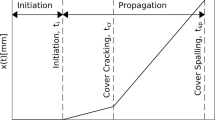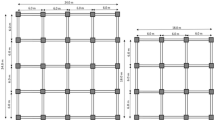Abstract
An approach to evaluate the structural reliability taking into account the degradation of the structural capacity due to corrosion of reinforced concrete buildings at the end of a time interval is proposed. The structural reliability is expressed in terms of the confidence factor, within a Demand and Capacity Factor Design format (DCFD). A new closed-form mathematical expression that considers the non-linear structural capacity degradation due to corrosion by means of a second degree polynomial function is developed. The confidence factors are obtained under the assumption that the structural capacity degradation due to corrosion follows a linear and non-linear function over a time interval. The structural reliability is obtained for a three-story reinforced concrete building subjected to two sets of real seismic ground motions recorded in Acapulco Bay Mexico. Both, aleatory and epistemic uncertainties are taken into account into the analysis. A maximum difference of 3.5% between both functions after 83 years from the construction of the building was found.
Similar content being viewed by others
References
Andrade, C., Alonso, C., and Molina, F. J. (1993). “Cover cracking as a function of bar corrosion: Part I-Experimental test.” Materials and Structures, Vol 26, No. 8, pp. 453–464, DOI: 10.1007/BF02472805.
Campos, D. and Esteva, L. (1997). “Hysteretic behavior and damage model for reinforced concrete beams.” Proc., 11th National Conference on Earthquake Engineering, Veracruz, Mexico (in Spanish).
Castañeda, H., Castro, P., González, C., and Genésica, J. (1997). “Modelo de difusión de cloruros en las estructuras de hormigón armado expuestas en la península de Yucatán (México).” Revista de Metalurgia, Vol. 33, No. 6, pp.387–392, DOI:10.3989/revmetalm.1997.v33.i6.834.
Celarec, D., Vamvatsikos, D., and Dolšek, M. (2011). “Simplified estimation of seismic risk for reinforced concrete buildings with consideration of corrosion over time.” Bulleting of Earthquake Engineering, Vol. 9, No. 4, pp.1137–1155, DOI: 10.1007/s10518-010-9241-3.
Choe, D. E., Gardoni, P., Rosowsky, D., and Haukaas, T. (2009). “Seismic fragility estimates for reinforced concrete bridges subject to corrosion.” Structural Safety, Vol. 31, No. 4, pp. 275–283, DOI: 10.1016/j.strusafe.2008.10.001.
Cornell, C. A. (1968). “Engineering seismic risk analysis.” Bulletin of the Seismological Society of America, Vol. 58, No. 5, pp. 1583–1606.
Cornell, C. A., Jalayer, F., Hamburger, R. O., and Foutch, D. A. (2002). “Probabilistic basis for the 2000 SAC/FEMA steel moment frame guidelines.” Journal of Structural Engineering, ASCE, Vol. 128, No. 4, pp. 526–533, DOI: 10.1061/(ASCE)0733-9445(2002)128:4(526).
Del Valle, A., Pérez, T., and Martínez, M. (2001). El fenómeno de la corrosión en estructuras de concreto reforzado, Instituto Mexicano del Transporte, Publicación No.182 (In Spanish).
Enright, M. P. and Frangopol, D. M. (1998). “Service-life prediction of deteriorating concrete bridges.” Journal of Structural Engineering, ASCE, Vol. 124, No. 3, pp. 309–317, DOI: 10.1061/(ASCE)0733-9445(1998)124:3(309).
Esteva, L. (1968) Basis for the formulation of decisions on seismic design, PhD Dissertation, Universidad Nacional Autónoma de México (In Spanish).
Esteva, L., Díaz-López, O., and García-Pérez, J. (2001). “Reliability functions for earthquake resistant design.” Reliability Engineering & System Safety, Vol. 73, No. 3, pp. 239–262, DOI: 10.1016/S0951-8320(01)00045-X.
Federal Emergency Management Agency (2000). Recommended Seismic Evaluation and Upgrade Criteria for Existing Welded Steel Moment-Frame Buildings, Report No. FEMA 351, SAC Joint Venture, Washington, D. C.
Frangopol, D. M., Lin, K. Y., and Estes, A. C. (1997). “Reliability of reinforced concrete girders under corrosion attack.” Journal of Structural Engineering, ASCE, Vol. 123, No. 3, pp. 286–297, DOI: 10.1061/(ASCE)0733-9445(1997)123:3(286).
Frangopol, D. M., Kong, J. S., and Gharaibeh, E. S. (2001). “Reliabilitybased life-cycle management of highway bridges.” Journal of Computing in Civil Engineering, Vol. 15, No. 1, pp. 27–34, DOI: 10.1061/(ASCE)0887-3801(2001)15:1(27).
Ghasemi, H., Brighenti, R., Zhuang, X., Muthu, J., and Rabczuk, T. (2015). “Optimal fiber content and distribution in fiber-reinforced solids using a reliability and NURBS based sequential optimization approach.” Structural and Multidisciplinary Optimization, Vol. 51, No. 1, pp. 99–112, DOI: 10.1007/s00158-014-1114-y.
Jalayer, F. and Cornell, C. A. (2009). “Alternative non-linear demand estimation methods for probability-based seismic assessments.” Earthquake Engineering and Structural Dynamics, Vol. 38, pp. 951–972, DOI: 10.1002/eqe.876.
Jensen, O. M., Hansen, P. F., Coats, A. M., and Glasser, F. P. (1999). “Chloride ingress in cement paste and mortar.” Cement and Concrete Research, Vol. 29, No. 9, pp. 1497–1504, DOI: 10.1016/S0008-8846(99)00131-3.
Liu, Y. and Weyers, R. E. (1998). “Modeling the time-to-corrosion cracking in chloride contaminated reinforced concrete structures.” ACI Materials Journal, Vol. 95, No. 6, pp. 675–680, DOI: 10.14359/410.
Liu, M. and Frangopol, D. M. (2005). “Multiobjective maintenance planning optimization for deteriorating bridges considering condition, safety, and life-cycle cost.” Journal of Structural Engineering, ASCE, Vol. 131, No. 5, pp. 833–842, DOI: 10.1061/(ASCE)0733-9445(2005)131:5(833).
Mariaca, L., Genesca, J., Uruchurtu, J., and Salvador, L. (1999). Corrosividad Atmosférica (MICAT-México), Plaza y Valdés, Mexico, pp. 195–196 (In Spanish).
Mexico City Building Code (2004) Reglamento de Construcciones del Distrito Federal, Gaceta Oficial (In Spanish).
Mori, Y. and Ellingwood, B. R. (1993). “Time-dependent system reliability analysis by adaptive importance sampling.” Structural Safety, Vol. 12, No.1, pp. 59–73, DOI: 10.1016/0167-4730(93)90018-V.
Powell, G. H. (1973). DRAIN 2D User’s Guide, Earthquake engineering research center, University of California Berkeley.
Rackwitz, R. (2001). “Reliability analysis—a review and some perspectives.” Structural Safety, Vol. 23, No.4, pp. 365–395, DOI: 10.1016/S0167-4730(02)00009-7.
Rainville, E. D. (1961). Intermediate Course in Differential Equations, John Wiley & Sons, New York, pp. 144–148.
Schmitt, G. (2009). Global needs for knowledge dissemination, research, and development in materials deterioration and corrosion control, World Corrosion Organization, New York.
Straub, D. (2009). “Stochastic modeling of deterioration processes through dynamic Bayesian networks.” Journal of Engineering Mechanics, ASCE, Vol. 135, No. 10, pp. 1089–1099, DOI: 10.1061/(ASCE)EM.1943-7889.0000024.
Thoft-Christensen, P. (2001). “What happens with reinforced concrete structures when the reinforcement corrodes.” Proc., 2th International workshop on Life-Cycle cost analysis and design of civil infrastructure systems, Yamaguchi, Japan, pp. 35–46.
Tolentino, D., Ruiz, S. E., and Torres, M. A. (2012). “Simplified closedform expressions for the mean failure rate of structures considering structural deterioration.” Structure and Infrastructure Engineering, Vol. 8, No. 5, pp. 483–496, DOI: 10.1080/15732479.2010.539067.
Torres, M. A. and Ruiz, S. E. (2007). “Structural reliability evaluation considering capacity degradation over time.” Engineering Structures, Vol. 29, No. 9, pp. 2183–2192, DOI: 10.1016/j.engstruct.2006.11.014.
Val, D. V., Stewart, M. G., and Melchers, R. E. (1998). “Effect of reinforcement corrosion on reliability of highway bridges.” Engineering Structures, Vol. 20, No. 11, pp. 1010–1019, DOI: 10.1016/S0141-0296(97)00197-1.
Val, D. V., Stewart, M. G., and Melchers, R. E. (2000). “Life-cycle performance of RC bridges: Probabilistic approach.” Computer-Aided Civil and Infrastructure Engineering, Vol. 15, No. 1, pp. 14–25, DOI: 10.1111/0885-9507.00167.
Vamvatsikos, D. and Cornell, C. A. (2002). “Incremental dynamic analysis.” Earthquake Engineering and Structural Dynamics, Vol. 31, No. 3, pp. 491–514, DOI: 10.1002/eqe.141.
Vu, K. A. T. and Stewart, M. G. (2000). “Structural reliability of concrete bridges including improved chloride-induced corrosion models.” Structural Safety, Vol. 22, No. 4, pp. 313–333, DOI: 10.1016/S0167-4730(00)00018-7.
Author information
Authors and Affiliations
Corresponding author
Rights and permissions
About this article
Cite this article
Tolentino, D., Carrillo-Bueno, C.A. Evaluation of Structural Reliability for Reinforced Concrete Buildings Considering the Effect of Corrosion. KSCE J Civ Eng 22, 1344–1353 (2018). https://doi.org/10.1007/s12205-017-1650-2
Received:
Revised:
Accepted:
Published:
Issue Date:
DOI: https://doi.org/10.1007/s12205-017-1650-2




